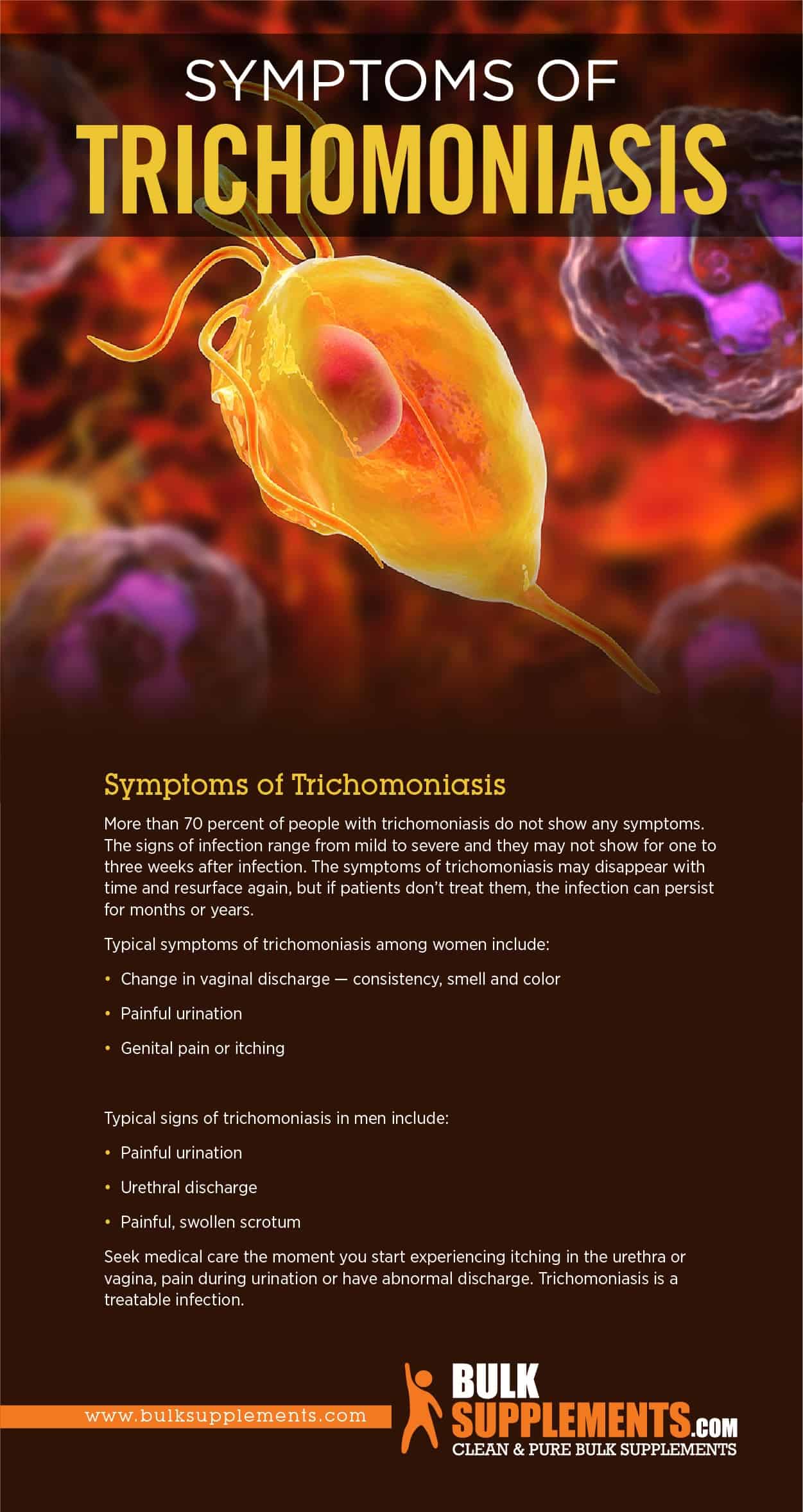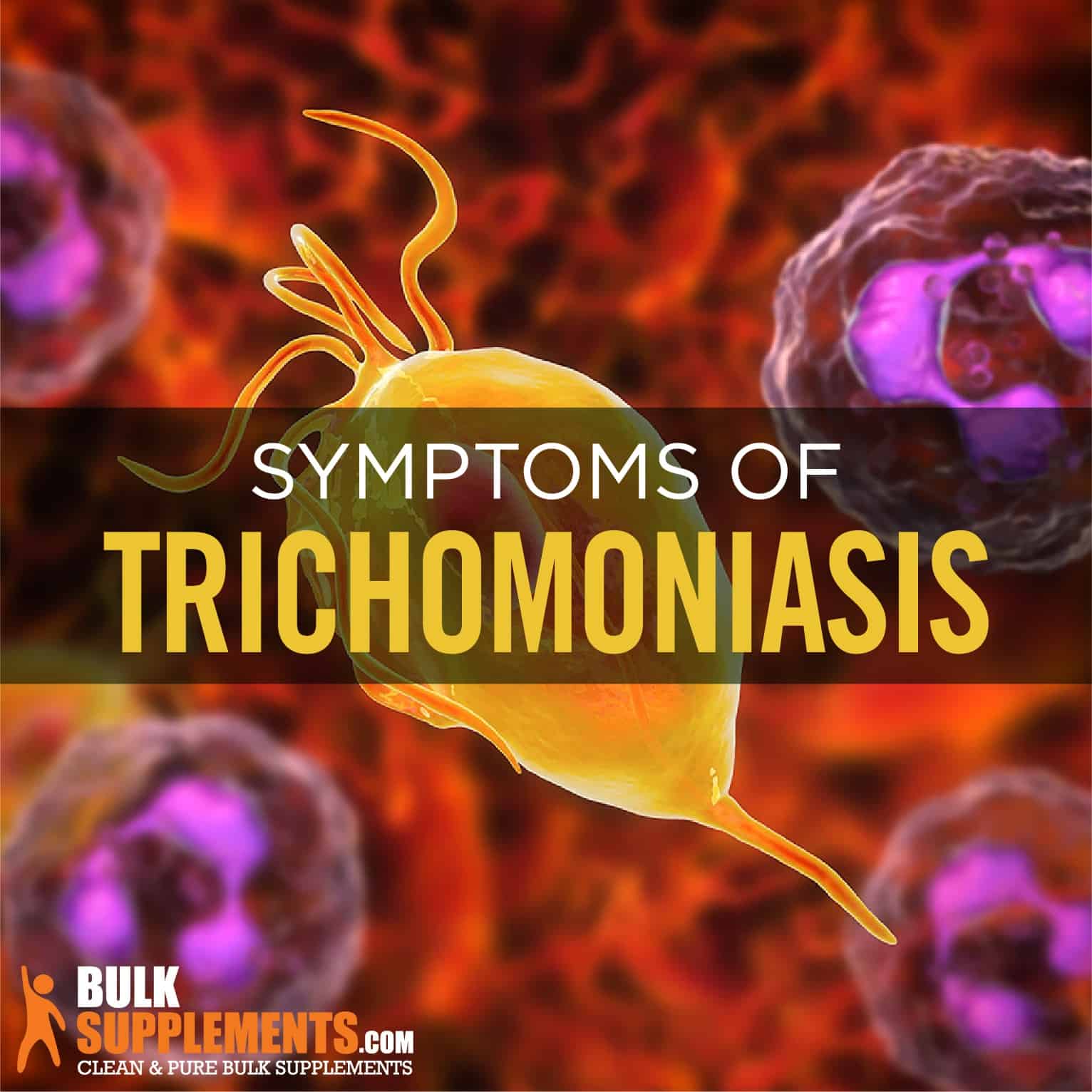What is Trichomoniasis?
As a sexually transmitted disease (STD), trichomoniasis, unfortunately, is quite common and caused by a protozoan parasite called Trichomonas vaginalis, also called “trich.” You catch it by having unprotected sexual intercourse. (x) These parasites are microscopic and are both parasitic and free-living. They multiply in humans, causing severe infections. (x)
Today, there are over three million cases of this disease in the United States, but fortunately, this infection has a cure. Trichomoniasis is difficult to diagnose because it is primarily asymptomatic (x) — producing or showing no symptoms. (x)
The infection is more common among women than men. Specifically, it predominantly affects African-American women more than Caucasian or Hispanic women, and older women are more likely to contract it than younger women. (x) (x)
Trichomoniasis can spread quickly without treatment and infect the entire urinary tract and other reproductive organs. In women, it usually infects the cervix, urethra, bladder and vagina. In men, it primarily affects the urethra. (x)
History of Trichomoniasis Vaginalis
In 1836, the first description of trichomoniasis came from scientist Alfred Francois Donne. However, research on the parasite took about 200 years to get started. By the 20th century, research has gone in phases, defining nutritional needs to develop an effective treatment. (x)
At first, viewed as a harmless vaginal colonizer or minor nuisance, research shows trichomoniasis has reached epidemic levels in several countries. The infection is about half of all curable STDs worldwide. There is even evidence of the parasite surviving in a swimming pool. Over the last 60 years, control of the disease happens with rapid tests, isolating and treating the STD. (x)
Symptoms of Trichomoniasis
More than 70 percent of people with trichomoniasis do not show any symptoms. (x) The signs of infection range from mild to severe, and they may not show for one to three weeks after infection. The symptoms of trichomoniasis may disappear with time and resurface again, but if patients don’t treat them, the infection can persist for months or years.
Typical symptoms of trichomoniasis among women include: (x)
- Change in vaginal discharge — consistency, smell and color
- Painful urination
- Genital pain or itching
Typical signs of trichomoniasis in men include: (x)
- Painful urination
- Urethral discharge
- Painful, swollen scrotum
Seek medical care the moment you start experiencing itching in the urethra or vagina, pain during urination or have abnormal discharge. Trichomoniasis is a treatable infection, and you should take care of it as soon as possible for your well-being. You don’t desire to infect your sexual partner either. (x)
Causes of Trichomoniasis
The cause of trichomoniasis is a protozoan called Trichomonas vaginalis. (x) It spreads from one person to another through sexual intercourse. Individuals in both heterosexual and same-sex relationships can pass it on to their partners, but it rarely infects the hands, mouth or anus.
Risk Factors for Trichomoniasis
Various factors and actions put some individuals at a higher risk of contracting trichomoniasis: (x)
- Unprotected sex
- History of trichomoniasis
- Multiple sexual partners
- History of other sexually transmitted infections
- Complications of Trichomoniasis
Trichomoniasis can cause a wide range of complications when left untreated. (x) For starters, trichomoniasis can make sex and urinate uncomfortably. In addition, the spread of infection throughout the reproductive organs increases the risk of contracting and spreading other sexually transmitted diseases, such as HIV. (x) (x) Your same behavior and circumstances that put you in jeopardy with trichomoniasis show an increased chance of HIV infection and other sexually transmitted infections (STI) or STD. (x)
Trichomoniasis increases the risk of giving birth prematurely for pregnant patients (x). The baby is more likely to be born at low birth weight and may have complications with growth and development. The mother can spread the infection to the baby as well. (x) (x) (x)
Diagnosing Trichomoniasis
The only way to diagnose trichomoniasis is to get a physical exam and then a lab test from a doctor. The lab test may take a urine sample from either a man or a woman. For women, doctors may use a “wet mount,” which samples discharge to observe under a microscope for parasites. If a doctor finds the infection in a woman’s Pap smear, they may take a vaginal culture. Diagnosis may also include a blood test for faster results, but they are not as accurate as a discharge sample. (x) (x) (x)
Treating Trichomoniasis
Most patients with trichomoniasis do not show symptoms and, therefore, rarely seek treatment. (x) But without treatment, trichomoniasis can spread and increase the risk of other sexually transmitted infections because of behavior and prior circumstance being repeated.
Trichomoniasis is easily treatable with one dose of antibiotics. Metronidazole or tinidazole are traditionally the treatment of choice. Research states that these antibiotics are safe for pregnant women, but women who receive tinidazole should stop breastfeeding until three days after their last dose. (x) (x) (x)Being diagnosed with trichomoniasis, your sexual partners also need testing and treatment. Avoid sexual activity until after the antibiotics cure the infection. Even after treatment, you can contract trichomoniasis again. Twenty percent of patients catch the parasite again within three months of treatment. (x) (x)

Preventing Trichomoniasis
The most effective way to trichomoniasis infection is to abstain from sex or practice monogamy — don’t be promiscuous. It’s not just a moral issue, it’s a health and well-being issue. Living a faithful one sexual partner life guarantees a significantly less chance of catching an STD or STI. (x) There are several steps to take to have a safe sex life with a low risk of infection. Some proactive steps include: (x)
- Condoms
Condoms are not entirely effective in preventing trichomoniasis infection. The protozoan can infect areas of the skin that the condom doesn’t cover. Be sure to put on the condom early before the penis comes in contact with the vagina. (x)
- Don’t Douche
Healthcare professionals usually advise women not to douche altogether. The vagina is a self-cleaning organ that hosts a lot of healthy bacteria. Douching eliminates some of the beneficial bacteria but increases the chances of infection. (x)
- Personal Items
It is possible to contract trichomoniasis from sharing personal items like swimwear or wet towels. However, the parasite cannot live outside of the body for long, so it is rare to spread through sharing personal items. (x)
- Talk Openly With Your Sexual Partner
Have an honest and open discussion with your sexual partner about your sexual history and the possibility of infection. Such a discussion can help you and your partner determine the best course of action to treat and manage trichomoniasis and other STDs and STIs.
Supplements for Trichomoniasis
Once you contact trich, you need to implement antibiotics right away. Follow your doctor’s recommendations for a healthier lifestyle. Also, ask about taking any new supplements. Some supplements to consider for assisting in the antibiotic treatment include:
- Pomegranate Extract Powder
Pomegranate extract powder is a powerful antioxidant with ellagic acid. Ellagic acid has many therapeutic qualities, involving antioxidants and anti-proliferative (inhibit cancer cell growth) effects. (x) (x) The safe dosage for this supplement is 750 mg two times a day. Pomegranate extract is an antioxidant, which protects the body from damage by free radicals. This product supports digestion and cardiac health. It also relieves arthritis and high blood pressure symptoms. (x)
- Ginger Root Extract Powder
Ginger root extract powder is a food-grade herbal product that promotes overall health. Ginger root has anti-inflammatory properties and ease problems with digestion and related issues. The suggested serving size for ginger extract is 1,000 mg once a day.
- Resveratrol Powder
This supplement is a natural antioxidant that promotes mental and digestive health. Resveratrol works to oxidize free radicals that cause damage to the body. Studies also suggest that it helps to minimize the symptoms of trichomoniasis by inhibiting the parasitic growth. (x) The safe serving size for this supplement is one capsule per day.
- Holy Basil Powder
Holy basil is a pure herbal product that promotes overall health and helps to relieve stress and anxiety. It also boosts immune function so the body can fight infections. The safe dosage for basil is 500 milligrams once or twice per day. This product is not safe for use if you are pregnant or nursing.
- Avocado
This fruit has all the nutritional properties your body needs to function correctly. In ancient cultures, avocado treated inflammation, diabetes and parasitic infections. (x) Avocados also support digestion and heart health. (x)
- Myrrh
Myrrh eliminates harmful bacteria, supports skin health, promotes healing of wounds and sores and reduces swelling and joint pains. A study using test tubes proved that myrrh reduced trichomoniasis vaginalis as a new anti-agent source. (x)
Where to Buy Supplements for Trichomoniasis?
You can purchase these supplements for Trichomoniasis at BulkSupplements.com. The company is an industry-leading manufacturer and distributor of pure dietary supplements.
BulkSupplements.com is not just a consumer brand. It also supplies pure ingredients to other food and supplement brands to make their products. All products at BulkSupplements.com are manufactured and tested according to current and proper manufacturing practices.
Are you interested in trying any of these supplements mentioned in this article as a possible solution to helping you with your Trichomoniasis Infection? Contact BulkSupplements.com to place an order today.
The Bottom Line
Trichomoniasis, also named “trich,” is a sexually transmitted infection or disease caused by protozoa, a parasite that multiples in your body. It affects almost 300 million people in the world each year. (x) Symptoms include vaginal discharge, painful and swollen scrotum and painful urination, as well as discomfort during sex.
Fortunately, this condition is treatable with antibiotics. But most people with this infection do not show any symptoms and do not seek treatment. Even after treatment, trichomoniasis can resurface if you don’t change your sexual habits — to prevent the disease, practice safe sex and monogamy.
Supplements have proven to inhibit the parasite and may help ease the discomfort, but seeking medical treatment for trich is the best way to handle the infection.
These statements have not been evaluated by the Food and Drug Administration. These products are not intended to diagnose, treat, cure or prevent any disease.


